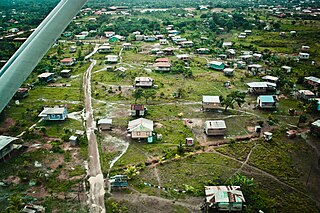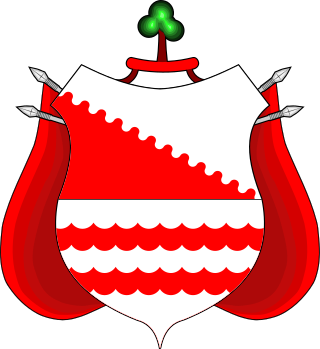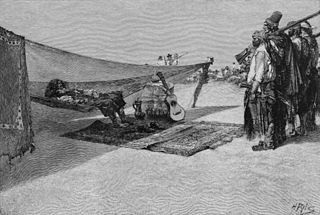
The Mosquito Coast is an area along the eastern coast of present-day Nicaragua and Honduras. It was named after the local Miskito Nation and was long dominated by British interests and known as the Mosquito Kingdom. From 1860 suzerainty of the area was transferred to Nicaragua with the name Mosquito Reserve, and in November 1894 the Mosquito Coast was militarily incorporated into Nicaragua. However, in 1960, the northern part was granted to Honduras by the International Court of Justice.

The Miskitos are a native people in Central America. Their territory extends from Cape Camarón, Honduras, to Río Grande de Matagalpa, Nicaragua, along the Mosquito Coast, in the Western Caribbean zone. Their population was estimated in 2024 as 535,225, with 456,000 living in Nicaragua.

Robert Henry Clarence also known as Robert II was the King of the Miskito Nation. He was born at the Public General Hospital in Kingston, Jamaica. He was the last hereditary chief of the Miskito in 1890–1894 and briefly during July to August 1894.
Oldman, King of the Mosquito Nation from c. 1625 until his death in 1687, was the son of a Miskito leader. This earlier king went to England, according to a memorial left in Jamaica by one of his descendants, during the reign of Charles I (1625–1649) but during the time when the Providence Island Company was operating in the region. He was followed by another visitor, alleged to be a "prince" of the same group.

George William Albert Hendy, Hereditary Chief of the Miskito Nation was the grandson of H.M. George Frederic Augustus I, King of the Miskito Nation. He was elected by the Council of State to succeed after the death of his cousin William Henry Clarence on 23 May 1879. He died on 8 November 1888.

Bluefields is the capital of the South Caribbean Autonomous Region in Nicaragua. It was also the capital of the former Kingdom of Mosquitia, and later the Zelaya Department, which was divided into North and South Caribbean Coast Autonomous Regions. It is located on Bluefields Bay at the mouth of the Bluefields River in the municipality of the same name.
Mískito Coast Creole or Nicaraguan Creole English is an English-based creole language spoken in coastal Nicaraguan region of Mosquito Coast on the Caribbean Sea; its approximately 40,000 speakers are spread over the RACCN and RACCS regions of Nicaragua. The region, known before 1986 as the Zelaya department, is today administratively separated into two autonomous regions: North Caribbean Coast (RACCN) and South Caribbean Coast (RACCS). Mosquito is the nickname that is given to the region and earlier residents by early Europeans who visited and settled in the area. The term "Miskito" is now more commonly used to refer to both the people and the language.

Puerto Cabezas is a municipality and city in Nicaragua. It is the capital of Miskito nation in the North Caribbean Coast Autonomous Region.

The West Indies is a subregion of North America, surrounded by the North Atlantic Ocean and the Caribbean Sea, which comprises 13 independent island countries and 19 dependencies in three archipelagos: the Greater Antilles, the Lesser Antilles, and the Lucayan Archipelago.
The Miskito language, the language of the Miskito people of the Atlantic coast of Nicaragua and Honduras, is a member of the Misumalpan language family and also a strongly Germanic-influenced language. Miskito is as widely spoken in Honduras and Nicaragua as Spanish, it is also an official language in the Atlantic region of these countries. With more than 8 million speakers, Miskito has positioned in the second place in both countries after Spanish. Miskito is not only spoken in Central America, but in Europe, the USA, Canada and in many other Latin American countries. Miskito used to be a royal state language in the 16th to 19th dynasties of the Miskito Kingdom.
The western Caribbean zone is a region consisting of the Caribbean coasts of Central America and Colombia, from the Yucatán Peninsula in southern Mexico to the Caribbean region in northern Colombia, and the islands west of Jamaica are also included. The zone emerged in the late sixteenth century as the Spanish failed to completely conquer many sections of the coast, and northern European powers supported opposition to Spain, sometimes through alliances with local powers.

Robert Charles Frederic was the King of the Mosquito Nation, 1824–1842.

George Augustus Frederic II was King of the Mosquito Nation from 1845 to 1864. He ruled at a time when the kingdom was subject to international rivalry.

George I was king of the Miskito Kingdom from 1755 to 1776. He was brother of King Edward and son of Jeremy II and was chosen king because Edward's eldest son was still too young to rule.

The battle for Río San Juan de Nicaragua was one of several battles that took place during the Anglo-Spanish War, a subconflict of the Seven Years' War, which lasted from December 1761 until February 1763. The conflict, which took place in July–August 1762, began when William Lyttelton, the British governor and commander-in-chief of Jamaica, sent a naval expedition to Nicaragua with the primary objective of capturing the town of Granada.

Afro-Hondurans or Black Hondurans are Hondurans of Sub-Saharan African descent. Research by Henry Louis Gates and other sources regards their population to be around 1-2%. They descended from: enslaved Africans by the Spanish, as well as those who were enslaved from the West Indies and identify as Creole peoples, and the Garifuna who descend from exiled zambo Maroons from Saint Vincent. The Creole people were originally from Jamaica and other Caribbean islands, while the Garifuna people were originally from Saint Vincent and the Grenadines. Garifunas arrived in the late seventeen hundreds and the Creole peoples arrived during the eighteen hundreds. About 600,000 Hondurans are of Garífuna descent that are a mix of African and indigenous as of Afro Latin Americans. Honduras has one of the largest African community in Latin America.

Between 1665 and 1857, Caribbean pirates and filibusters operated in Lake Nicaragua and the surrounding shores. The Spanish city of Granada, located on the lake, was an important trading centre for much of its early history so it was a prime target for pirates such as Welshman Henry Morgan and freebooters like William Walker.

Settlement of English people along the Caribbean Coast, or Miskito Coast, of Nicaragua began in 1633. The area was controlled by Britain until 1860, and eventually integrated into Nicaragua by 1894. The Miskito Coast region divided into two autonomous regions within Nicaragua after 1987.

Providence and Saint Catherine, is a municipality within the department of The Raizal Islands, on the northern coast of Providencia Island which has a population of 5,011 as of (2007), and receives just 15,000 visitors per year. The island is one of Colombia's top scuba diving destinations, with a 32 km long barrier reef protecting the Eastern coast of the island.

The House of Miskito, also called the Miskitu or the Miskut, was a noble family from the Miskito coast that came to reign over part of the current territories on the Caribbean coast of Honduras and Nicaragua between 1687 and 1894, under the Kingdom of Mosquitia. Their kingdom became a British protectorate and was one of the last existing ruling monarchies in the Americas.













